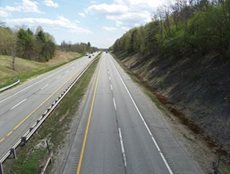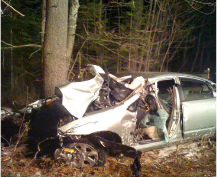Understanding Roadway Clear Zones
The Maine Turnpike occupies a right of way that is generally 300 feet wide. This leaves about 105 feet from the edge of pavement to the edge of Turnpike property in most locations. Maine is the most forested state in the nation. Trees inevitably grow on Turnpike property over time. Although trees can be beautiful, the periodic clearing of trees to create clear zones along the highway is essential to assure the safety of motorists for three key reasons:
 1) Fewer Deadly Fixed Objects
2) Less Shade Means Less Ice and Salt
3) Better Visibility Means Fewer Wildlife Crashes
1) Fewer Deadly Fixed Objects
2) Less Shade Means Less Ice and Salt
3) Better Visibility Means Fewer Wildlife Crashes
 Fewer Fixed Deadly Objects
Fewer Fixed Deadly Objects
Regrettably, motorists sometimes leave the roadway. They may slide on black ice, hydroplane during rain storms, fall asleep late at night, veer off to avoid an animal, or careen off in a collision. Whatever the reason, hitting a tree can turn an inconvenient accident into injury or death. Running into trees and other “deadly fixed objects” is the number one cause of traffic accident deaths in Maine.
Less Shade Means Less Ice and Salt

Obviously, one of the great benefits of trees in the summer is shade. In the winter, however, shade creates ice. All Maine drivers know how treacherous ice is, but they may not think about how effective simple sunlight can be to melt it. Without sunlight, more salt is required, which is costly and detrimental to the environment.
 Better Visibility Means Fewer Crashes with Wildlife
Better Visibility Means Fewer Crashes with Wildlife
A wider clear zone along highways gives motorists a better chance to see moose, deer, and other animals before they enter the road. On a high-speed Interstate like the Turnpike, this can make a life and death difference for both animals and drivers.
How This May Impact You
For reasons explained above, the Maine Turnpike must often clear trees from land close to the road. It is a matter of public safety. Sometimes the aesthetic result is not pleasing and sometime adjoining landowners prefer to see the trees remain. However, the safety of Turnpike travelers is the most important concern.
To replace these trees, it is sometimes possible to plant smaller evergreens or shrubs to provide a visual buffer for nearby property owners. Small, dense evergreens do not create harmful obstructions within the “clear zone” and they may help to hold back wind-driven snow from the highway. Although some people argue that foliage provides a sound barrier, it has been our experience that the presence or absence of trees or shrubs has little or no impact on sound transmission.
Not all soils are suitable for such growth and it may take years for new plants to mature to the point where they provide an effective screen. If any affected landowners have suggestions for the Turnpike’s annual planting program, they are welcome to call the Right of Way Department at Turnpike Headquarters.
Turnpike trees are cut either by our maintenance forces or by independent contractors. If you have questions about a clearing project or the annual planting program, feel free to contact the Turnpike Right of Way Department at (207) 482-8350.